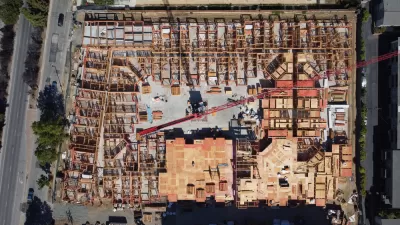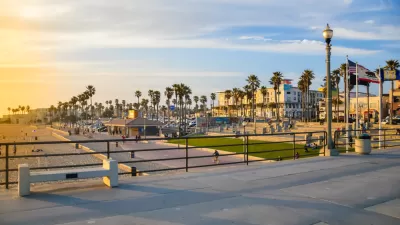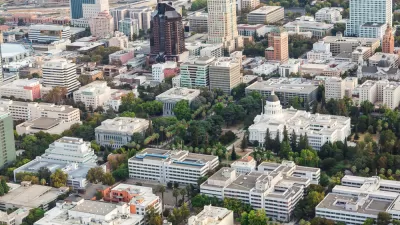Despite a few high-profile failures, the California State Legislature has approved a steady drumbeat of pro-development reforms that loosen zoning restrictions. The state raised the stakes on its zoning reforms this week.

California Governor Gavin Newsom signed senate bills 8, 9, and 10, and Assembly Bill 1174, into law this week—each intended to spur the creation of more housing supply by loosening zoning restrictions. The California State Legislature approved SB 9 and SB 10 late in August, but the governor's signature waited until the conclusion of a recall vote which ultimately ended in his favor.
The California State Legislature has provided a battleground for housing and zoning policy reform for several years now, with SB 9 attracting most of the attention of forces on either side of the issue in the 2021 legislative session. According to a statement released by Gov. Newsom's office to announce the signing of the bills, the California Housing Opportunity and More Efficiency (HOME) Act (SB 9) "facilitates the process for homeowners to build a duplex or split their current residential lot, expanding housing options for people of all incomes that will create more opportunities for homeowners to add units on their existing properties."
Proponents of the bill are calling the governor's action the end of single-family zoning in California (although some would argue that the statewide legalization of accessory dwelling units in 2016 had the same effect). Regardless of where one draws the line, California now undisputedly joins Oregon as the two state's making the most aggressive use of state preemption to override local zoning laws to reverse the racist roots of exclusionary zoning and, potentially, provide more affordable housing options for residents.
As for SB 10, the press release provides this explanation:
SB 10 by Senator Scott Wiener (D-San Francisco) creates a voluntary process for local governments to access a streamlined zoning process for new multi-unit housing near transit or in urban infill areas, with up to 10 units per parcel. The legislation simplifies the CEQA requirements for upzoning, giving local leaders another tool to voluntarily increase density and provide affordable rental opportunities to more Californians.
Senator Scott Wiener, of course, authored some of the state's previous, failed attempts at dramatic overhauls of the planning and zoning status quo in the name of a supply side approach to the state's housing affordability crisis, SB 827 and SB 50.
SB 8, authored by State Senator Nancy Skinner (D-Berkeley), "extends the provisions of the Housing Crisis Act of 2019 (SB 330) through 2030. The Housing Crisis Act of 2019, which was scheduled to expire in 2025, accelerates the approval process for housing projects, curtails local governments’ ability to downzone and limits fee increases on housing applications, among other key accountability provisions."
Also receiving a mention in the press release is AB 1174, by Assemblymember Tim Grayson (D-Concord), "an urgency measure that makes changes to the existing streamlined, ministerial approval process for housing development in jurisdictions that have not yet made enough progress towards their allocation of their regional housing needs." The Regional Housing Needs Assessment process, underway right now throughout the state, is proving continuously controversial and contentious.
California YIMBY, a leading proponent of the state's recent pro-development legislation, also put out a press release celebrating the final approval of the four bills, saying the bills will "significantly advance the goal of increasing housing affordability and availability throughout the state, especially in urban areas and near transit." Livable California, the high-profile group on the other side of the issue, was calling for the governor to veto the bills up until the 11th hour.
FULL STORY: Governor Newsom Signs Historic Legislation to Boost California’s Housing Supply and Fight the Housing Crisis

Pennsylvania Mall Conversion Bill Passes House
If passed, the bill would promote the adaptive reuse of defunct commercial buildings.

Coming Soon to Ohio: The Largest Agrivoltaic Farm in the US
The ambitious 6,000-acre project will combine an 800-watt solar farm with crop and livestock production.

World's Largest Wildlife Overpass In the Works in Los Angeles County
Caltrans will soon close half of the 101 Freeway in order to continue construction of the Wallis Annenberg Wildlife Crossing near Agoura Hills in Los Angeles County.

California Grid Runs on 100% Renewable Energy for Over 9 Hours
The state’s energy grid was entirely powered by clean energy for some portion of the day on 37 out of the last 45 days.

New Forecasting Tool Aims to Reduce Heat-Related Deaths
Two federal agencies launched a new, easy-to-use, color-coded heat warning system that combines meteorological and medical risk factors.

AI Traffic Management Comes to Dallas-Fort Worth
Several Texas cities are using an AI-powered platform called NoTraffic to help manage traffic signals to increase safety and improve traffic flow.
City of Costa Mesa
Licking County
Barrett Planning Group LLC
HUD's Office of Policy Development and Research
Mpact Transit + Community
HUD's Office of Policy Development and Research
Tufts University, Department of Urban and Environmental Policy & Planning
City of Universal City TX
ULI Northwest Arkansas
Urban Design for Planners 1: Software Tools
This six-course series explores essential urban design concepts using open source software and equips planners with the tools they need to participate fully in the urban design process.
Planning for Universal Design
Learn the tools for implementing Universal Design in planning regulations.


























